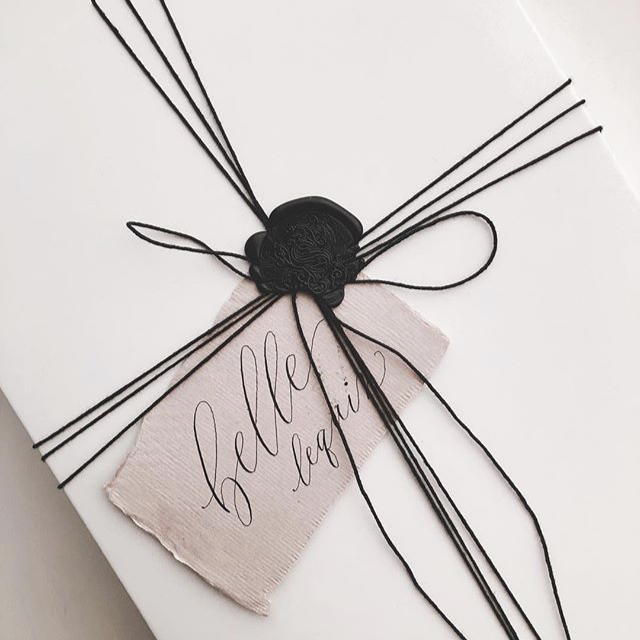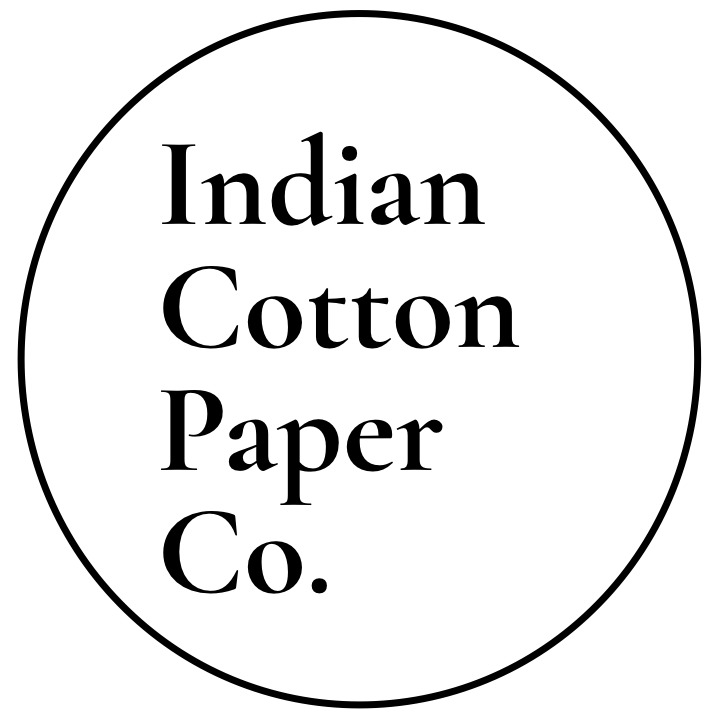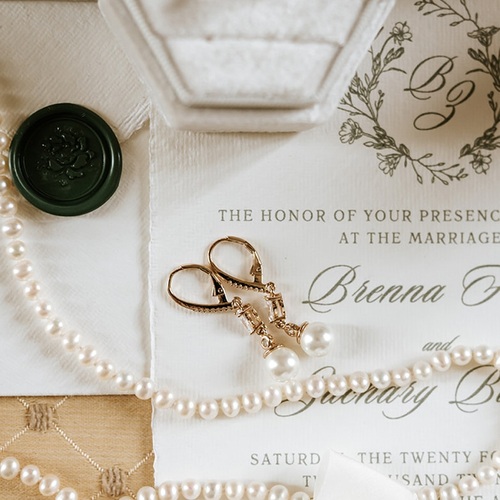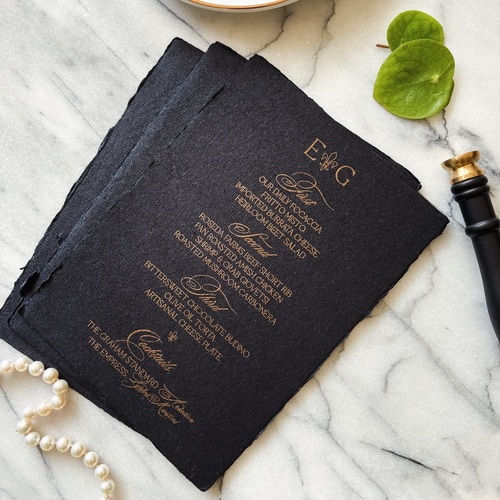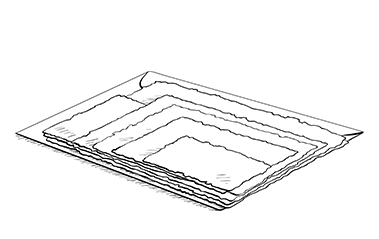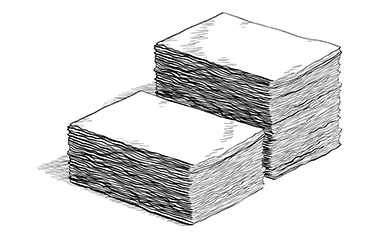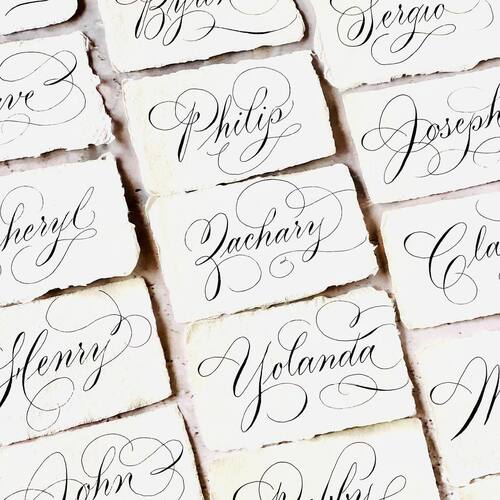Artist Q&A guides
Advice for calligraphy on handmade cotton paper
Modern calligraphy on handmade paper can be difficult to navigate for a beginner – from learning which nib will best suit the natural texture, to finding the optimal ink consistency. We've collected essential tips to help, covering materials, tools, and techniques from some of our favourite calligraphy artists – including advice on why it helps to take your time.
Meet the artists
Each of our calligraphy artists runs their own calligraphy business creating unique stationery with their own aesthetic for weddings and special occasions. They give their insights for beginners drawing from their own perspective and experience with handmade cotton paper.

Sen Mendiola
Sen describes her style as organic, simple, minimal, and intentional, with an aesthetic of subtle elegance. She loves scribing love notes and immortalising vows through pen and ink. For Sen, practicing calligraphy is a form of meditation.

Claire Falco
Claire runs a photography and stationery business based in Evans, Georgia. Her stationery design is feminine, floral-driven, and full of calligraphed, hand-painted, and luxury details.
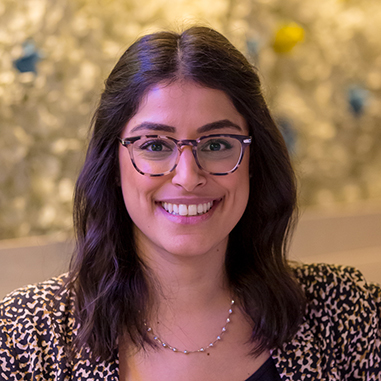
Kejal Ashra
Kejal runs Calligraphy by Kiki working on commissions for weddings and events. Her style is contemporary and versatile, inspired by geometry and clean patterns, as well as contrasting pops of colours. Kejal also hosts public and corporate calligraphy workshops, championing the mindful benefits of practising calligraphy.
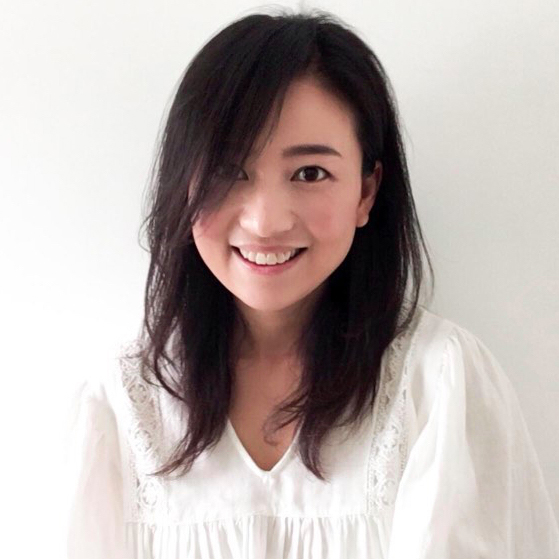
Younghee Kim Nawata
Younghee runs Le Lettere Lettering Co. which was founded in London and is now based in Tokyo. She creates stylish hand lettered paper items for weddings, parties, and other events.
Questions & Answers
Calligraphy and handmade paper
Inks
- What inks do you recommend?
- What should I do if my ink bleeds on the paper?
- Do you have any advice for writing on watercolour washes?
Nibs
- What type of nibs do you recommend?
- How should I maintain my nibs?
- What should I do if my nib is catching fibres from the paper?
Design
Calligraphy and handmade paper
Why do you use handmade paper?
"It is certainly no secret that I love working with handmade paper, to the point that it is becoming a part of my artistic identity. I love the texture, its tactile cotton element that feels different on your hand, the natural deckle edges that can invoke an appeal of rustic or old-world charm. I love the perfect imperfections, the variations that bring so much character to the medium. Let's just say, they bring so much character and beauty in the paper-loving world of stationers, calligraphers and artists, in the era of modern technology."
"Pointed pen calligraphy on handmade deckle edge paper is elegant, classic and timeless. They are perfect for wedding invitations, place cards and menus. I like to add gold - ink or foil - to make them even more gorgeous. Handmade deckle edge paper is beautiful, classy, and goes well with antique and vintage decorations such as wax seals."
"There is nothing quite like handmade paper! It can take your stationery design to the next level. I really love using Indian Cotton Paper Co. as one of my paper sources. Their product is ideal for printing, letter press, gold foil, watercolor, and calligraphy."
Inks
What inks do you recommend?
"I use black Sumi ink which I find has the best consistency and doesn't tend to bleed on to the paper."
"Higgins Eternal is the best of all time for me. Basic black gouache mixed with water works nicely as well."
"My current favorite ink options are Dr. Ph. Martin’s Bleed Proof White, walnut ink (great for an old world feel), black Sumi Ink (add some water), Dr. Ph. Martin’s Iridescent Copper Plate Gold, and for small projects metallic watercolor painted onto nib."
What should I do if my ink bleeds on the paper?
"If you're having trouble with ink bleeding, try experimenting with the optimum ink consistency. You can add a couple of drops of gum arabic to your ink if it needs thickening slightly, to achieve that perfect consistency."
"Ink flow is simple to navigate: if your ink is flowing too fast causing your to re-dip too frequently or bleeding around the edges add gum arabic. If your ink isn’t flowing fast enough (skipping, or not releasing from the tines) add distilled water incrementally, I do so using a pipette."
Do you have any advice for writing on watercolour washes?
"In some cases where you need to put a watercolour wash as a background design, try to add some gum arabic to your ready-made ink or gouache mixture to hold up the ink more and prevent it from bleeding."
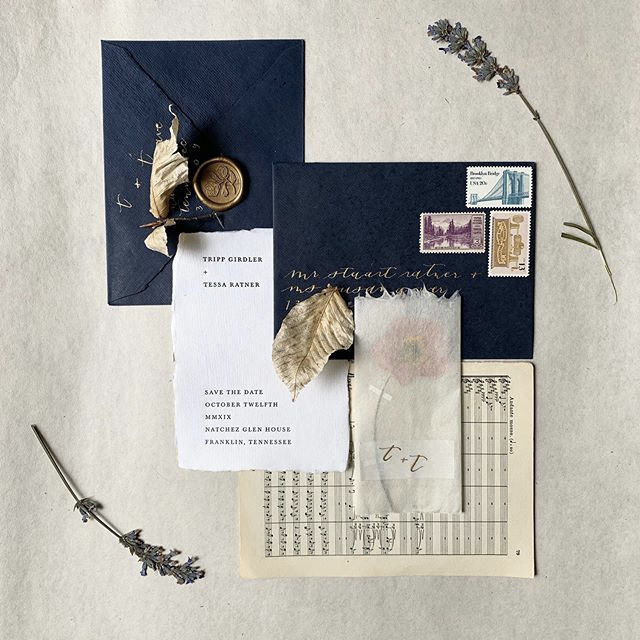
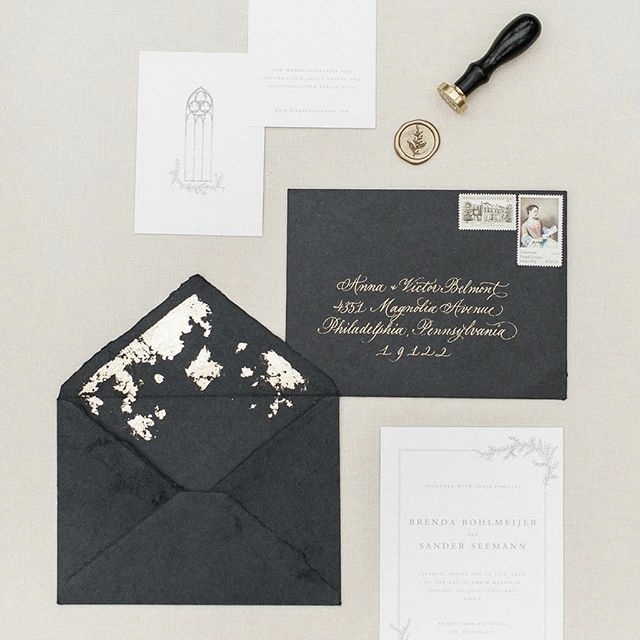
Nibs
What type of nibs do you recommend?
"My go to nib is Nikko G, I find it works best for handmade paper."
"After some trial and error, I found that the G nibs (Nikko G or Tachikawa G) and vintage nib like Henry 605 works best for me. These nibs are not too pointy, which prevents snagging more fibres than you wanted to."
"I use Nikko G nibs as it has the perfect amount of flex and doesn't catch on the upward strokes, so long as your pen holder is positioned as flat against the paper as possible."
"I really like the Nikko G and Hiro Leonardt 41 nibs."
How should I maintain my nibs?
"If you are writing lots of words, make sure to wipe and clean your nibs more often than usual to ensure that no fibre strands are building at the tip, that causes inkblots. Writing on textured paper is challenging and may take longer than usual, be patient, breathe and enjoy the process."
"Keep your nib super clean - wash out the ink with water and wipe your nib, ideally between words. Always get ready to pause whenever you feel something in your nib, wash and start over."
What should I do if my nib is catching fibres from the paper?
"If your nib is catching, splattering, or picking up fibers from the paper lower the angle of your wrist and apply less pressure. You can also use an older or duller nib that isn’t as prone to catch."
Design
What should I consider when designing with handmade paper?
"When it comes to handmade paper keep it simple - often I worked with brides-to-be who have been drawn to the texture of the paper foremost, with the calligraphy simply adding the finishing, luxury touch to their place cards or envelopes. The premium nature of the product speaks for itself, so keep the design and/or calligraphy minimalist to let the paper do the talking."
Paper weights
What should I know about different paper weights?
"Handmade papers come in different weights to cater to specific purposes. A medium weight that usually comes at 200gsm is perfect for calligraphy, digital or flat printing and sometimes can take a soft or shallow letterpress impression. The heavyweight comes at 210-300gsm is meant for letterpress with deep impression and mostly suitable for painting and drawing using different media."
Pens
Do you have any tips for writing with pens?
"Naturally, it's important to use the right tools. For brush lettering, I use a size 0 round paintbrush with Finetec PearlColours - the metallic colours come out very striking against the pastel Indian Cotton Paper Co. shades and absorbs nicely into the paper."
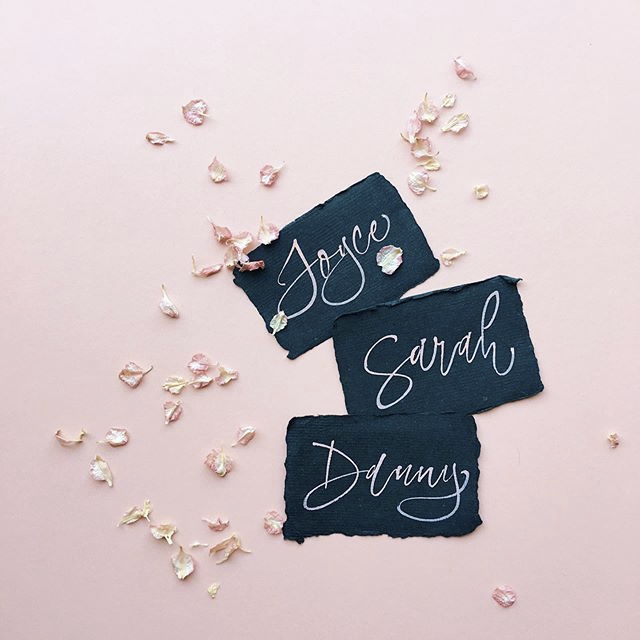
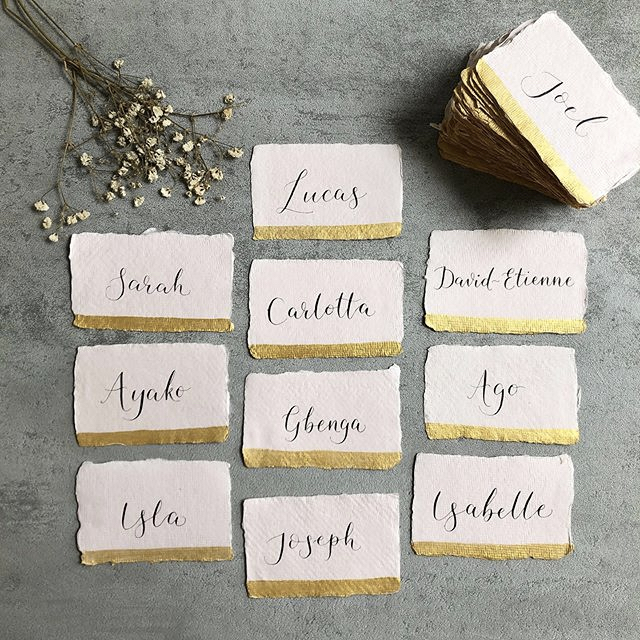
Comfort
What should I do if I'm finding it difficult?
"Using handmade papers for calligraphy is a bit challenging at first, especially if you are used to writing on smooth papers. Remember that these papers are handmade and your nib may snag and catch fibres as you write. My tip is to write slower than usual, have a conscious effort to have a lighter hand and make the ink a bit more fluid or thinner so that it will glide easier from your nib. It can be a challenging medium to use but could be tamed as long as you are willing to learn, explore and be patient. Once you get to know its characteristics and how it behaves to specific applications, you will love it and the artistic beauty it brings to your work."
"Plan more time than you normally would when writing on textured handmade paper. It's a little unpredictable at first, for example, when you're figuring out the optimum ink consistency for the paper, but once you get the hang of it, the process will naturally speed up."
What tips do you have for staying comfortable when writing?
"I use a straight pen holder for delicate work ensuring my fingertips are as close to the end of the pen holder as possible, so that I have maximum control. As you'll be going at a slower pace than normal, it's natural to feel hand cramp after 30 minutes or so. If that happens, take a well-earned break and then come back to the job once your hand feels more relaxed."
Mistakes
What's the best way to correct mistakes?
"After I finished writing and I have unwanted spreading, spots and splatters on the paper, I use razor blade or sand eraser very gently to pick them off. Tombow MONO Sand Eraser for Ink is my favourite tool for correction."
"If you need to erase a pencil guide or draft, best to use a kneaded eraser after the ink has thoroughly dried up."

